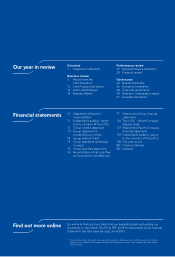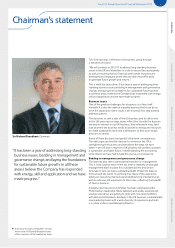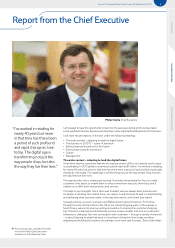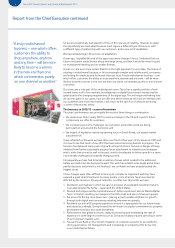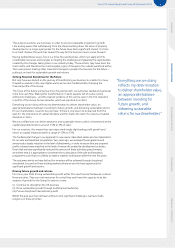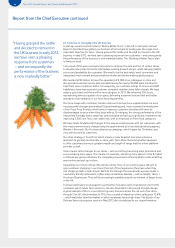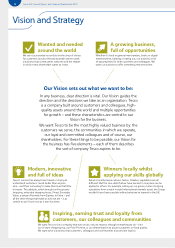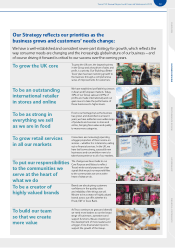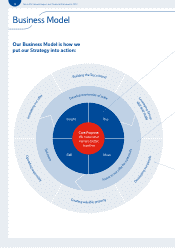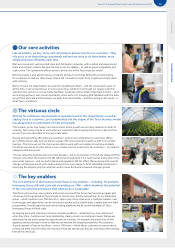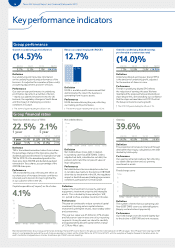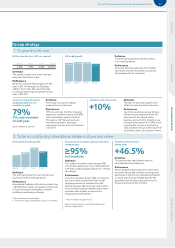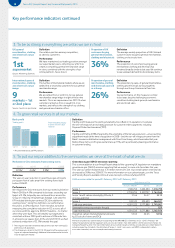Tesco 2013 Annual Report Download - page 12
Download and view the complete annual report
Please find page 12 of the 2013 Tesco annual report below. You can navigate through the pages in the report by either clicking on the pages listed below, or by using the keyword search tool below to find specific information within the annual report.
8Tesco PLC Annual Report and Financial Statements 2013
Report from the Chief Executive continued
(iii) Pursue disciplined international growth
The single most important step we took in 2012/13 in our international business was to
launch a strategic review of Fresh & Easy in the United States and in April we confirmed our
decision to exit the market. This was not a decision lightly reached but in keeping with what
I have said about the need to move the business forward, and to do so in a disciplined way –
the US business simply did not offer the prospect of acceptable returns in an appropriate
time frame.
Whilst the process of exit is ongoing, and as such the full financial effect of it is yet to be fully
determined, we have written down the assets of the business and booked provisions for
future liabilities – which together have impacted profit after tax by £(1) billion.
Fundamentally, we invest overseas because we have the opportunity to generate returns by
using our skill and scale in high-growth economies, where retailing is less mature, to build
substantial market positions and strong consumer franchises.
This opportunity is unchanged and exploiting it remains an important element of our strategy.
We have had success – 32% of our sales and 29% of our profit now comes from outside the
UK, and we have market-leading businesses in eight of our 11 international markets. Over two
decades of international development we have learned a huge amount about what works and
what doesn’t – getting the pace and scale of expansion right for local conditions, getting the
balance right between local front-end, global skills in sourcing and logistics and being ready
to partner where appropriate. Utilising this knowledge is critical to driving future returns from
our international business.
Looking forward, these lessons will guide our approach to internationalisation. We will stay
focused for the foreseeable future on our existing markets, and on allocating significant
capital only where we see very good prospects of strong investment returns. And where
we do invest, it will be with a clear emphasis on lower capital intensity routes to growth
such as convenience and online.
I have categorised our countries into three groups to explain what this approach means
in practice:
• In Thailand, South Korea and Malaysia, where we have strong market positions and
economic growth remains more robust, our businesses have substantial further potential
for growth. These markets continued to deliver excellent performance in 2012/13,
although the headline growth was obscured by the c.£(100) million profit impact of
legislation to restrict large store shopping hours in South Korea. Looking forward, the
opportunities to build on our already strong positions in these fast-growing economies
remain compelling and are therefore our highest international priority.
• In the European markets where we have solid, in some cases, market-leading businesses,
but where the economic backdrop has been damaging to performance, our emphasis will
be on holding our position, driving further benefits of skill and scale and making targeted
investment in specific opportunities, such as online and convenience retailing. At present,
the economic context remains unfavourable with continued recession and austerity
in all of our markets – the Republic of Ireland, the Czech Republic, Hungary, Poland and
Slovakia. Long term, these remain fundamentally attractive markets for Tesco both
as growth markets and as markets where multichannel retailing is still in its infancy.
• In China, Turkey and India, which are exciting long-term growth opportunities, we will push
on – but carefully – adopting a steadier pace of growth that is, importantly, more cautious
about capital allocation. Our model in India is to work with the Tata Group, and we are
unable to commit our own capital under current regulations. However, the model works,
we like our partner and we are learning a lot about the market. We will commit new capital
to China and Turkey, but only for those opportunities that pass our rigorous investment
appraisal targets. We will be committing less capital in the coming years than we have
done in the past – at least until we can demonstrate a significant step forward towards
our objective of stronger returns.
“ We will stay focused for the
foreseeable future on our
existing markets, and on
allocating significant capital
only where we see very
good prospects of strong
investment returns.”




